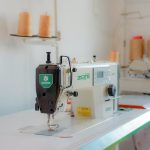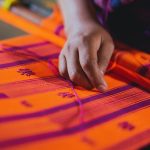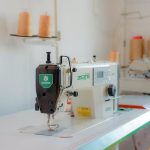Wondering if you should backstitch a zigzag stitch? It's a common question among sewers looking to master their craft. Understanding when and why to backstitch with a zigzag stitch can elevate the quality and durability of your sewing projects.
In this guide, we'll explore the importance of backstitching with a zigzag stitch, when it's necessary, alternatives to backstitching, potential issues with skipping backstitch, and tips for securing a zigzag stitch.
By the end, you'll have a clear understanding of whether or not you should backstitch when using a zigzag stitch and how to do so effectively.
Key Takeaways
- Backstitching with a zigzag stitch is important for securing stitches and maintaining the integrity of the sewing project.
- It provides extra durability and longevity to seams, especially for stretchy or loosely woven fabrics.
- Backstitching is necessary for high-stress areas and to prevent unraveling or fraying of the seam.
- There are alternatives to backstitching, such as using a lockstitch or tying off threads manually, but they may not provide the same level of reinforcement and security.
Importance of Backstitching With Zigzag Stitch
When using a zigzag stitch, it's crucial to backstitch at the beginning and end of your seam to secure the stitches in place. This ensures stitch security, preventing unravelling and maintaining the integrity of your sewing project. Without backstitching, the ends of the seam are left vulnerable, and the stitches may easily come undone over time.
Additionally, backstitching helps to stabilize the thread tension at the start and end of the seam, preventing any potential loosening of the stitches.
By backstitching with a zigzag stitch, you reinforce the seam, providing extra durability and longevity to your work. This is particularly important when working with stretchy or loosely woven fabrics, where the thread tension plays a critical role in preventing the stitches from pulling out.
Therefore, incorporating backstitching into your sewing practice, especially when using a zigzag stitch, is a fundamental technique for ensuring the security and stability of your seams. It's a small step that yields significant benefits in the quality and longevity of your sewing projects.
When Backstitching Is Necessary
To determine the necessity of backstitching with a zigzag stitch, consider the fabric type and the intended use of the seam. When to backstitch can depend on several factors:
- Fabric Type: Delicate or stretchy fabrics may require backstitching at the beginning and end of a seam to prevent unraveling.
- Intended Use of the Seam: For high-stress areas like garment seams or items that will undergo frequent washing, backstitching can reinforce the seam and prevent it from coming undone.
- Zigzag Stitch Application: When using a zigzag stitch for seam finishing or to prevent fraying, backstitching at the beginning and end of the seam is essential to secure the threads.
- Benefits of Backstitching: Backstitching helps to lock the stitches in place, providing added durability to the seam.
- Backstitching Techniques: Understanding different backstitching techniques, such as using the reverse button on your sewing machine or manually reversing the stitch, can ensure secure seam endings.
Considering these factors will help you determine when backstitching is necessary when using a zigzag stitch, ultimately leading to more durable and reliable seams.
Alternatives to Backstitching
Considering the fabric type and intended use of the seam, you may opt for alternatives to backstitching when using a zigzag stitch.
One alternative to backstitching is using a lockstitch at the beginning and end of the seam. To do this, sew a few straight stitches in place at the beginning and end of the seam to secure the threads.
Another option is tying off the threads manually. After sewing the seam with a zigzag stitch, leave long thread tails and use a hand-sewing needle to weave the tails back through the stitches to create a secure knot.
Additionally, you can use a fabric adhesive or fray check to secure the ends of the seam. However, it's important to note that these alternatives may not provide the same level of stitch reinforcement and security as backstitching or using a lockstitch.
When deciding on the best alternative, consider the fabric type, seam stress, and desired stitch security. Ultimately, the chosen method should ensure the seam's durability and stability.
Potential Issues With Skipping Backstitch
Skipping backstitching at the beginning and end of a zigzag stitch can lead to unraveling of the seam threads. This can result in weaker seams that are more prone to coming apart during use and washing. To avoid potential thread unraveling, there are several steps you can take. First, you can apply a small amount of fray check to the end of the seam to help prevent unraveling. Additionally, experimenting with the tension settings on your sewing machine can create a more secure zigzag stitch. If you prefer not to backstitch, you can explore other stitch reinforcement techniques, such as sewing a few extra straight stitches at the beginning and end of the seam. You can also use thread locking techniques, such as tying a knot at the end of the seam or using a thread locking solution. Finally, selecting a high-quality, durable thread that's less likely to unravel can contribute to stronger seams. By being mindful of potential thread unraveling and employing appropriate stitch reinforcement techniques, you can achieve more durable and secure zigzag stitches.
Tips for Securing Zigzag Stitch
When zigzag stitching, it's essential to secure the stitch to prevent unraveling and ensure the seam's durability. To enhance stitch security when using a zigzag stitch, pay close attention to your machine settings.
First, adjust the thread tension to ensure that the stitches are neither too loose nor too tight. Proper tension will prevent the thread from looping or breaking, ultimately securing the zigzag stitch.
Additionally, consider the stitch length. A shorter stitch length can contribute to a more secure zigzag stitch, especially when working with stretchy or delicate fabrics. Experiment with different settings on a scrap piece of fabric to find the optimal combination of thread tension and stitch length for your specific project.
Frequently Asked Questions
Can You Use a Different Type of Stitch to Secure the Ends of a Zigzag Stitch Instead of Backstitching?
To secure the ends of a zigzag stitch without backstitching, you can use different stitches or alternatives. Try experimenting with backup options or alternative securing methods to find the most suitable technique for your project.
What Are the Consequences of Not Backstitching a Zigzag Stitch?
If you don't backstitch a zigzag stitch, the consequences could be unraveling. Alternatives include using different securing techniques like tying off the ends, using fabric glue, or using a different stitch to secure the edges.
How Can You Ensure That the Zigzag Stitch Won't Unravel Without Backstitching?
To prevent unraveling, secure the zigzag stitch using stitch securing techniques such as sewing a few extra stitches at the beginning and end, or using a fabric glue or fray check. These methods help reinforce the stitch without backstitching.
Are There Any Special Techniques for Securing the Beginning and End of a Zigzag Stitch Without Backstitching?
To secure the beginning and end of a zigzag stitch without backstitching, there are alternative methods. Consider using securing thread, machine embroidery techniques, or decorative stitches. These techniques can provide a strong and professional finish.
What Types of Projects or Fabrics Require Backstitching With a Zigzag Stitch?
When working on projects with delicate fabrics or those prone to puckering, it's essential to secure the ends of a zigzag stitch. While backstitching is common, alternative methods like hand tying or using a securing stitch are also effective.
- Tetron Fabric for Marine Applications: Durability and Use Cases - June 18, 2025
- Tetron Fabric for Outdoor Furniture: Weather Resistance and Care - June 18, 2025
- Tetron Fabric for Wall Coverings: Style and Application Tips - June 18, 2025







